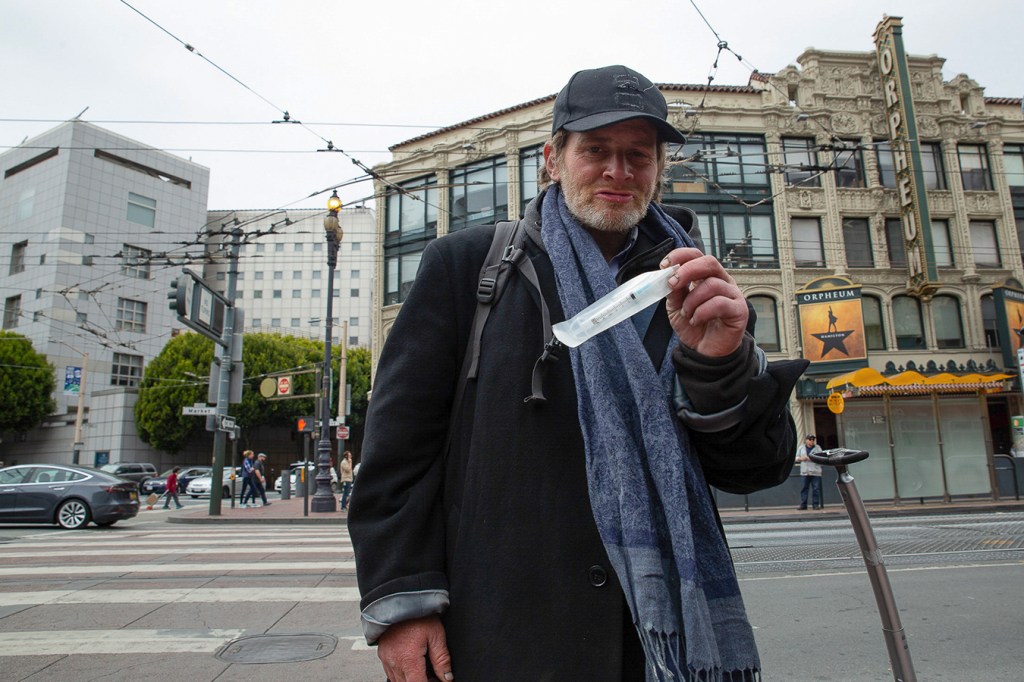The man was out of his wheelchair and lay flat on his back just off San Francisco’s Market Street, waiting for the hypodermic needle to pierce his skin and that familiar euphoric feeling to wash over him.
The old-timer, who appeared to be in his 60s, could not find a viable vein, so a 38-year-old man named Daniel Hogan helped him. Hogan, a longtime drug user originally from St. Louis, leaned over the older man, eyeing his neck as he readied a syringe loaded with the powerful synthetic opioid fentanyl.
Hogan called the man a “jellyfish” because most of his veins had collapsed from years of intravenous drug use and he rarely bled when pricked. But the older guy still had his jugular vein, and for Hogan that would work just fine.
Hogan’s hands were pink and swollen, bearing scars and scabs from years of daily drug use and the harshness of life on the streets. But those hands were skilled in the art of street phlebotomy. He slid the needle into the man’s neck and pushed the plunger.
Hogan, who said he had taken fentanyl every day for the past two months, explained that he’d developed a tolerance for the drug, and the dose he gave himself would kill a less experienced user. So, he gave the older man only a fraction of that amount.
In case it was too much, Hogan was ready with a vial of naloxone, the overdose-reversal drug.
Grim drug scenes like this play out every day on the streets surrounding San Francisco’s Civic Center — an area that spans the hard-luck sidewalks of the Tenderloin district and the transitional Mid-Market neighborhood, home to tech titans Twitter and Uber.
The area has become a beachhead for fentanyl, which has killed tens of thousands across the United States and is beginning to make itself felt in California.
The drug, which can shut down breathing in less than a minute, became the leading cause of opioid deaths in the United States in 2016. It is increasingly sought out by drug users, who crave its powerful high.
Carus displays a bag of fentanyl.(Brian Rinker for KHN)
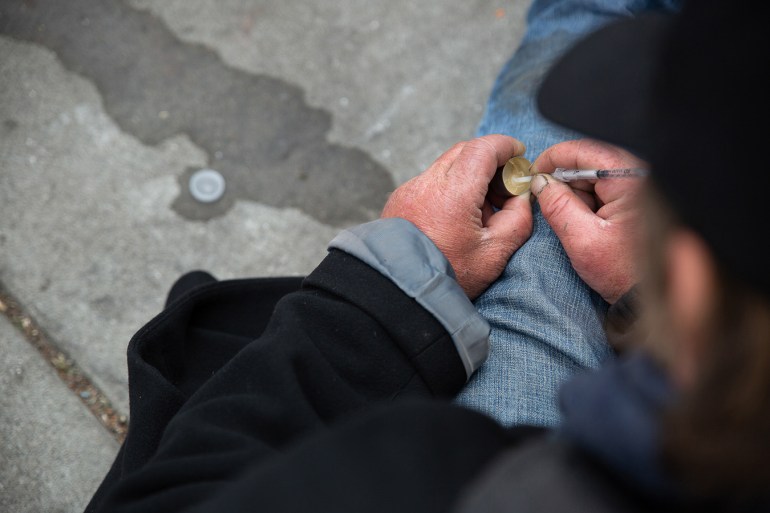
Carus mixes fentanyl with water in a “cooker” — equipment often distributed at needle exchanges. (Brian Rinker for KHN)
They feel a measure of security because many of their peers carry naloxone, which can quickly restore their breathing if they overdose.
Data suggests that in San Francisco the users may be reversing as many overdoses as paramedics — or more. In both cases, numbers have risen sharply in recent years.
In 2018, San Francisco paramedics administered naloxone to 1,647 people, up from 980 two years earlier, according to numbers from the city’s emergency response system.
That compares with 1,658 naloxone-induced overdose reversals last year by laypeople, most of them drug users, according to self-reported data from the DOPE Project, a Bay Area overdose prevention program run by the publicly funded Harm Reduction Coalition. That’s nearly double the 2016 figure.
“People who use drugs are the primary witnesses to overdose,” said Eliza Wheeler, the national overdose response strategist for the coalition. “So it would make sense that when they are equipped with naloxone, they are much more likely to reverse an overdose.”
The widespread availability of naloxone has radically changed the culture of opioid use on the streets, Hogan said. “In the past, if you OD’d, man, it was like you were really rolling the dice.” Now, he said, people take naloxone for granted.
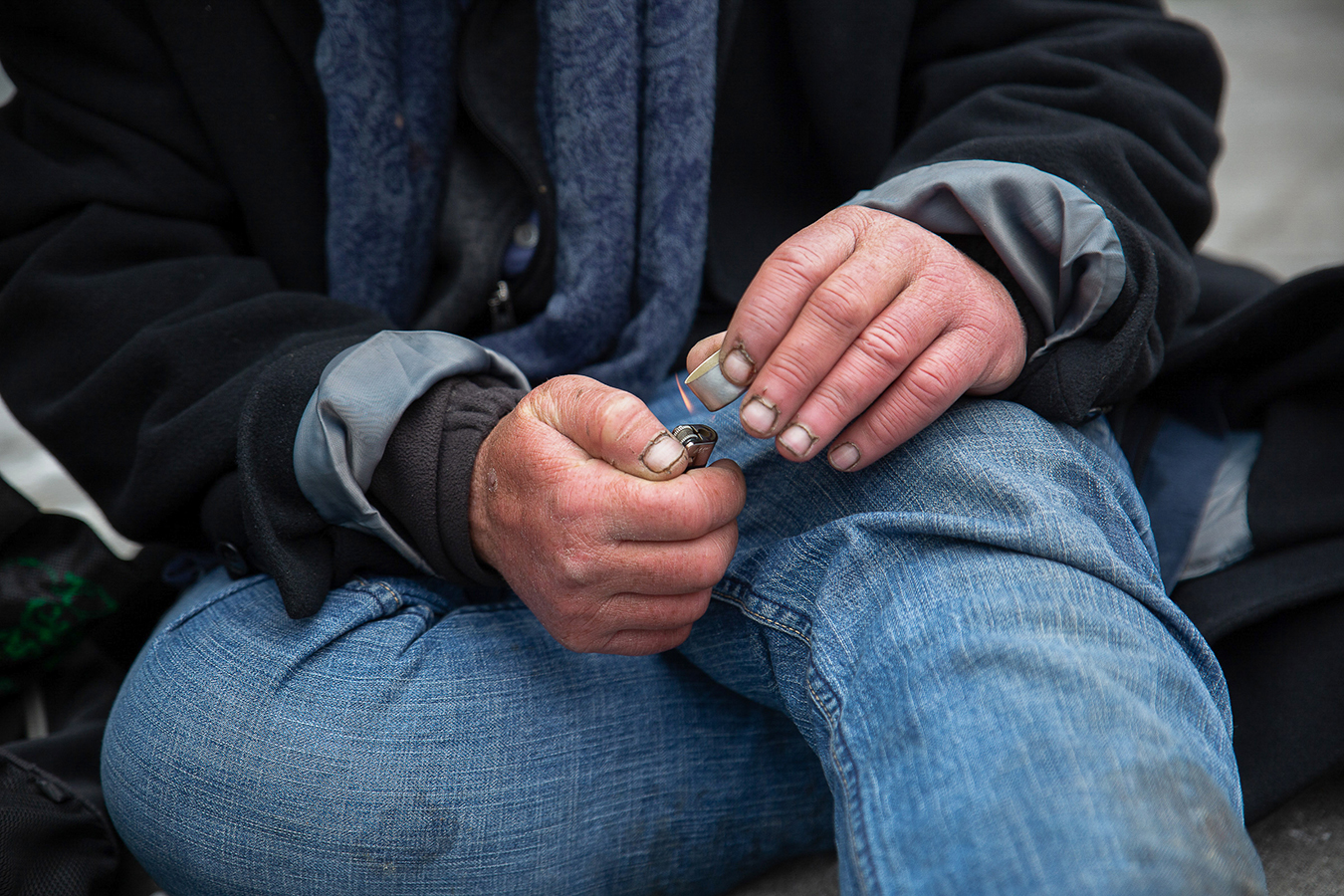
Carus prepares fentanyl shots for himself and his friend Bud. (Brian Rinker for KHN)
“I feel like as long as there is Narcan around, the opiates can’t kill you,” said Nick Orlick, 26, referring to one of the brand names for the overdose reversal drug.
As he huddled in the recess of a building along Mission Street, around the corner from high-rise luxury apartments, Orlick explained that he’d been revived with naloxone 15 times in recent years.
Despite fentanyl’s growing presence in San Francisco and other parts of California, it has not hit the Golden State nearly as hard as the rest of the country.
In 2017, 28,466 people across the U.S. died from overdoses involving synthetic opioids, which include fentanyl and related compounds, according to data from the Kaiser Family Foundation. California, which represents 12% of the country’s population, had 536 of those deaths — fewer than 2% of the total. (Kaiser Health News, which produces California Healthline, is an editorially independent program of the foundation.)
However, use of fentanyl is likely to grow in San Francisco and Los Angeles, as people get accustomed to it and begin to prefer its more intense high, said Ricky Bluthenthal, professor of preventive medicine at the Keck School of Medicine of the University of Southern California, who researches injection drug use.
In California, as in many other states west of the Mississippi, heroin is smuggled in the form of a gooey or hard black tar. This “black tar” heroin, “a well-known garbage drug,” is diluted with fillers, which induces some users to seek out the much more powerful effects of fentanyl, said Kristen Marshall, manager of the DOPE Project.
Fentanyl is dangerous not only because it is up to 50 times more potent than heroin, but also because people often take it unknowingly when their dealers mix it in with street drugs such as heroin. However, the black tar is difficult to mix with fentanyl, and that may help protect drug users who might otherwise ingest it unwittingly, experts say.
But even if they overdose on fentanyl, it’s not necessarily a death sentence. The widespread practice by community organizations in San Francisco and Los Angeles of distributing naloxone to the drug-using population also helps explain California’s lower rate of deaths from fentanyl and other opioids, harm reduction workers and researchers say.

On the streets around San Francisco’s Civic Center, homeless drug users often duck into alcoves, alleys or tents for a moment of privacy amid the bustle of government employees, tourists and tech workers. (Brian Rinker for KHN)
On the streets around San Francisco’s Civic Center, homeless drug users gather on sidewalks with their dogs, some huddling under blankets to smoke their white, powdered fentanyl through hollowed-out pens. Others inject it, often ducking into alcoves, alleys or tents for a fleeting moment of privacy amid the bustle of government employees, tourists and tech workers. Some of them overdose in plain sight.
They employ various methods to reduce the overdose risk. Some, like Daniel Hogan, take methamphetamine or smoke crack between injections to keep themselves alert. Another technique is to delay the full dose by pushing the plunger only partway down.
If gathered as a group, they often stagger their fentanyl use so one of them will be physically able to administer naloxone.
One recent May afternoon near Market Street, a thin man in his early 40s who called himself Bud slid a needle into his arm and slowly pushed the plunger down, stopping every so often to gauge the effects of the fentanyl.
“Hey, stop there. Pull it out,” said his friend Seth Carus, 55. Bud’s eyes were vacant and his mouth drooped — telltale signs the fentanyl had taken hold.
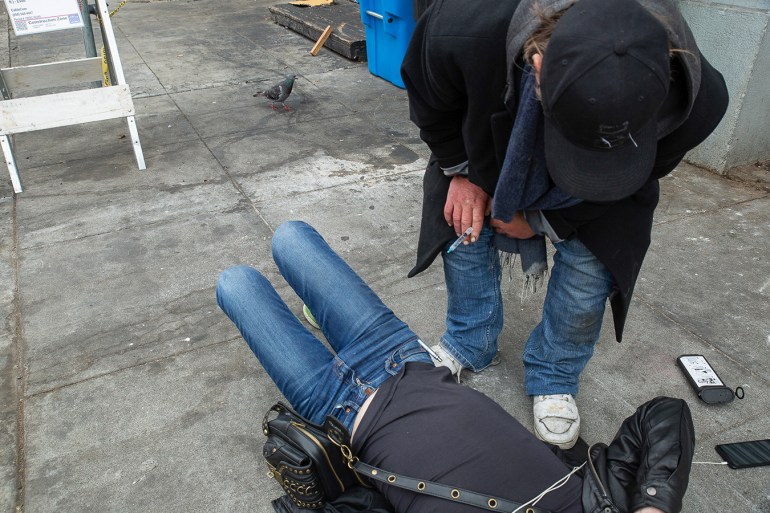
Carus is ready with naloxone for Bud, who has just overdosed, but Bud comes to before he needs the medication.(Brian Rinker for KHN)

As the police arrive, Carus comforts Bud after his overdose.(Brian Rinker for KHN)
Bud, wearing tight clothing and a blue beret, didn’t listen. He pushed the plunger all the way. Five minutes later, the color drained from his face, his eyes opened wide, his jaw locked and his entire body went stiff as he lay on the sidewalk.
Carus, living on the streets and a fentanyl user himself, sprang into action. He prepared a shot of naloxone and told a bystander to call 911.
But before Carus could administer the overdose reversal drug, Bud began to stir. Carus cradled him in his arms as the police arrived, followed quickly by the paramedics, who put Bud in an ambulance.
Carus blamed himself as he bent over and cried. The fentanyl was his, and he had been trying to do Bud a favor by getting him high.
A while later, Bud emerged from the ambulance and embraced his friend. “You did the right thing, man,” he told Carus. “I did the shitty drug addict thing. You said to stop, and I didn’t listen.”
This story was produced by KFF Health News, which publishes California Healthline, an editorially independent service of the California Health Care Foundation.



